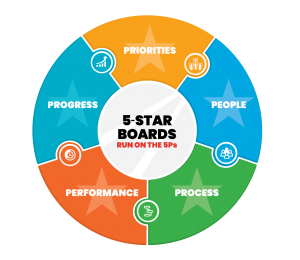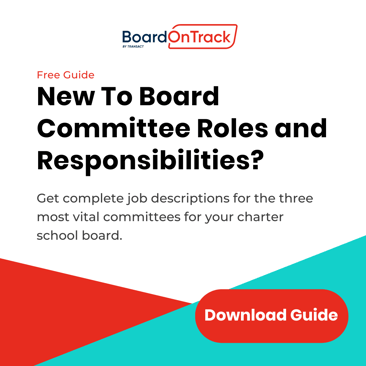To drive exceptional results for kids, your organization needs an exceptional board.
Exceptional boards define their priorities clearly, in line with the organization’s priorities.
But, the most successful boards don’t stop there. They put their goals to work for them…like a GPS to success.

Boards that have a clear set of articulated priorities and stay focused on them throughout the year cannot only achieve success year after year, but they can also look back and see exactly how they got there.
It’s why our five Ps for five-star boards start with Priorities. They’re your building blocks for a wildly successful year.
Learn How BoardOnTrack Can Help You:
What gets measured is what gets done.

Does your board have goals? Can each trustee clearly articulate your board’s priorities for the year ahead?
When you’re not aligned on one set of goals, it’s easy to get sidetracked. And, suddenly, each meeting feels like a maze of maybes. Your board is reacting to what seems important in the moment or just following operational models. You’re not contributing strategically to the organization’s needs.
To deliver on your charter’s promise, your board needs to think about more than what needs to be done today or at the next meeting. You need to consider what the organization needs, at a strategic level, and in three-to-five-year spans. How can you know you’re on track to show up where you should five years from now? It’s about your goals.
The best way to make progress in the short amount of time you have together as a board is to focus on your priorities and your performance as a governance team.
With goals in place, your board is able to set and maintain a focus on what matters, foster a sense of team collaboration, and measure your progress.
So, rather than feeling lost in a labyrinth of the day-to-day, you have your goals as a GPS to guide you through. Because what gets measured gets done.
Your Board’s Goals Are Not Your CEO’s Goals
Before we dive into how to set your board’s goals, let’s get clear about what board goals even are. The best place to start is to acknowledge that your board’s goals will differ from your CEO’s goals.
Combined, they’ll help strengthen your board-CEO partnership and help your governance team to meet the organization’s goals.
Board goals clearly articulate how the board will add value to the organization. Each of the board’s goals should be owned by a specific committee. And, when rolled up altogether, those committee goals make up the board’s overall goals.
Meanwhile, the CEO’s goals articulate what the CEO is expected to deliver each year. They focus on organizational performance metrics and often tie directly to your charter, your accountability plan with your authorizer, and your annual CEO evaluation. For example, teacher hiring, satisfaction, retention; parent satisfaction; or test scores.
Your Board Should Have Aspirational and Operational Goals
Board goals can –and should — be both operational and aspirational.
Operational goals are the core annual tasks that tie to your charter agreement.
These are the things you need to get done each year to have a functioning organization — fiscal oversight, hiring and evaluating teachers, for example.
Aspirational goals are short- and long-term reach goals.
They’re goals you’ll work towards upon completing an operational objective. In short, they’re how you will change the world.
You should strive to focus on your aspirational goals once the operational objectives become routine. These may seem very ambitious, even insurmountable, to a brand-new organization and its founding board.
But, you can intentionally strive to make the operational items routine so that they are no longer “goals,” but expectations…and you free up some mental bandwidth for the aspirational.
Six Steps to Set Your Board’s Goals and Achieve Them
Set your goals and achieve them with our step-by-step guide to clear, measurable, realistic goals. With seven simple steps, you can use your goals as your guide to success.
Step 1: Align your organization’s priorities
What are the most important things that your organization needs to do this year?
Your organization’s priorities are the big initiatives or efforts that your team needs to be most focused on in order to stay on track to meet and exceed your charter promises.
With your organizational priorities for this year in place, you’ll be ready to determine the board’s role in addressing those priorities.
Step 2: Decide your board’s priorities
The board and the CEO contribute uniquely to the organization’s priorities.
As a team, decide exactly how your board will contribute to your organization’s priorities. And, as you decide how you’ll contribute this year, be honest with yourselves about your board’s real impact to date, and align on what you want it to be.
Step 3: Structure for success
The most common reason boards allow their goals to fall through the cracks is simple and solvable: not having the structure in place to get the right things done.
To meet {and exceed!} your board’s goals, you’ve got to be structured for success.
Each board priority needs to have a committee to champion it. The right trustees must be strategically assigned to the right committees. Senior-level staff members and strong board officers will keep everyone moving in the right direction.
What if you don’t have the right people, or the right structure, to manage your priorities? It’s a common problem.
Step 4: Build your board’s goals
Each committee will translate the organization’s and board’s priorities into board goals. And those goals must be SMART. SMART board goals are: Specific, Measurable, Attainable, Relevant, and Timebound.
For each organization-level or board-level priority that merits board work, a committee is assigned to develop SMART goals that define how the board will contribute. And often, multiple committees will contribute in different ways to a single priority.

Step 5: Discuss & approve your board’s goals
Your full governance team plays a role in understanding and approving your board’s goals. Allow your CEO time to participate in each committee’s goal-setting process, as well as the full board’s conversation. Ensure that your board, as a whole, understands and approves the committees’ goals. And double-check for any interdependencies; discuss how you’ll coordinate efforts.
Step 6: Get to work & stay on track to make an impact
Planning is only as good as the action that follows it. No matter how big and audacious your goal is, the answer to achieving it is the same: one task at a time.
By working backward from two key milestones, you can create an action plan that defines and assigns every step along the way. Your action plan ensures your board isn’t reliant on the heroic efforts of one or two people.
For each board goal, start by asking yourself: 1} By when does this goal need to be achieved? and 2} When do we need to vote on it?
Put your goals into action at meetings & annual retreats progress
Use your goals to keep every meeting focused and strategically valuable.
At every board meeting and committee meeting, review your goals and progress towards meeting them. This keeps the board’s focus on the priorities for the year, not the personalities in the room. Perform quarterly pulse checks and do a deep dive at your annual retreat.
Learn more about how to put the power of a strategic annual retreat to work for your board in our free board goals email course.
Keep reaching for that higher bar!
When you set goals, ensure you can achieve them, and track your progress towards them, you know you’re on track to get exceptional results for the kids counting on your charter school. Whether you’re renewing your charter, connecting with the community, or making the case to potential funders, you can show that you’re on track because your board’s goals are on track.
That’s part of why your board’s goals are an integral part of your journey to reaching a higher bar every year. Having worked with hundreds of boards, we’ve proven what makes exceptional boards.
What goals will your organization accomplish this year? Will you achieve them? When you do, remember there is always a higher bar; keep reaching.
Learn How BoardOnTrack Can Help You:





